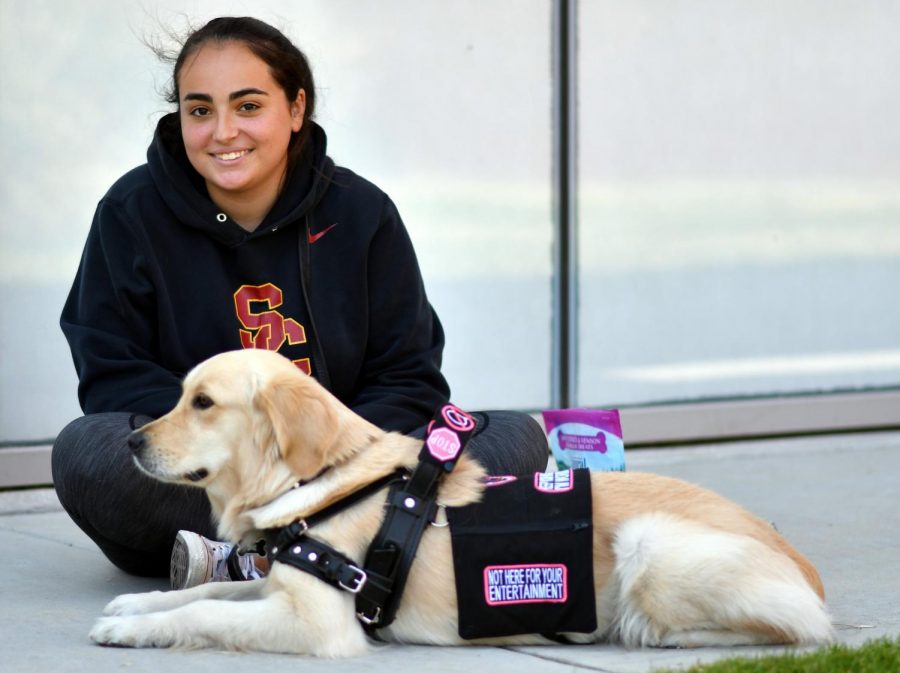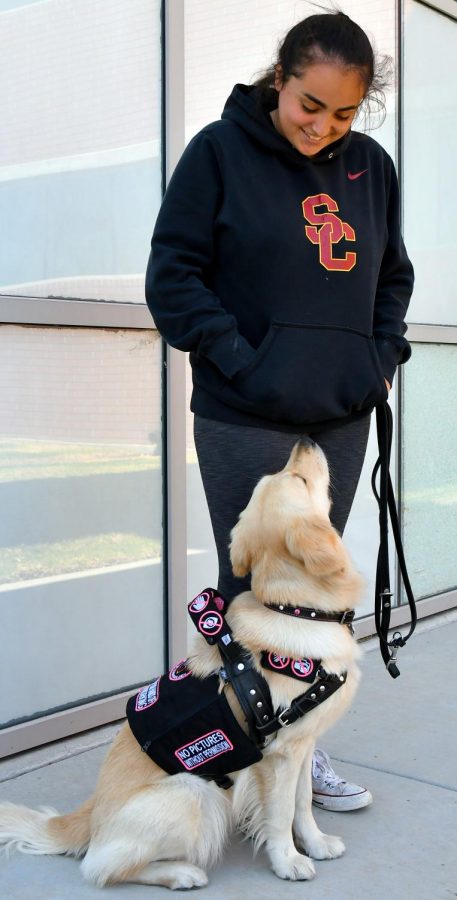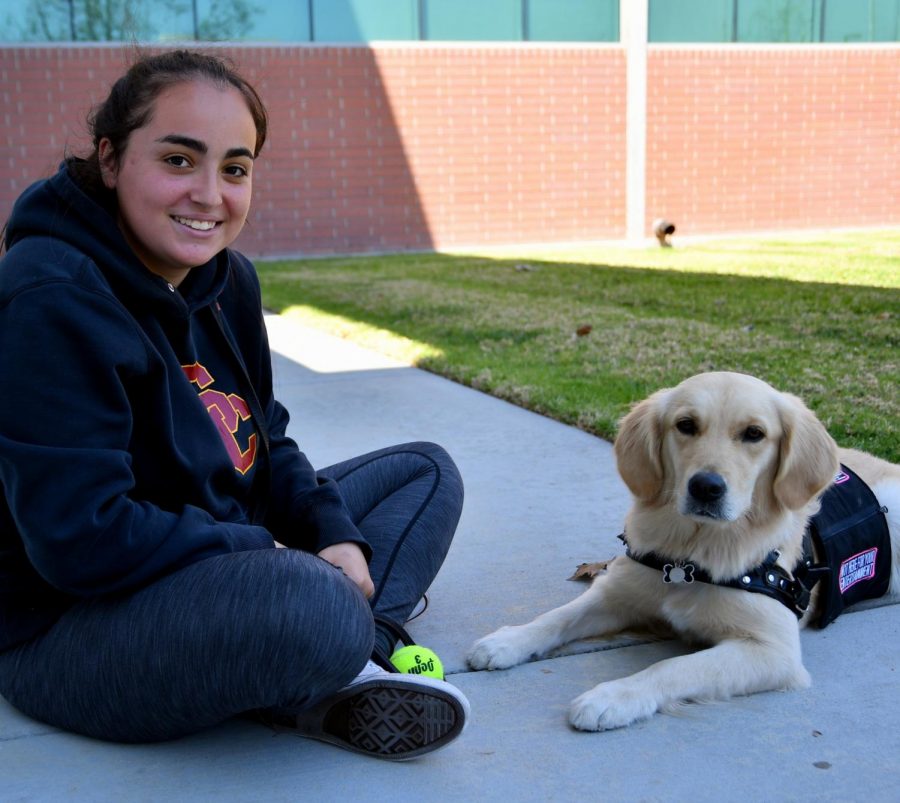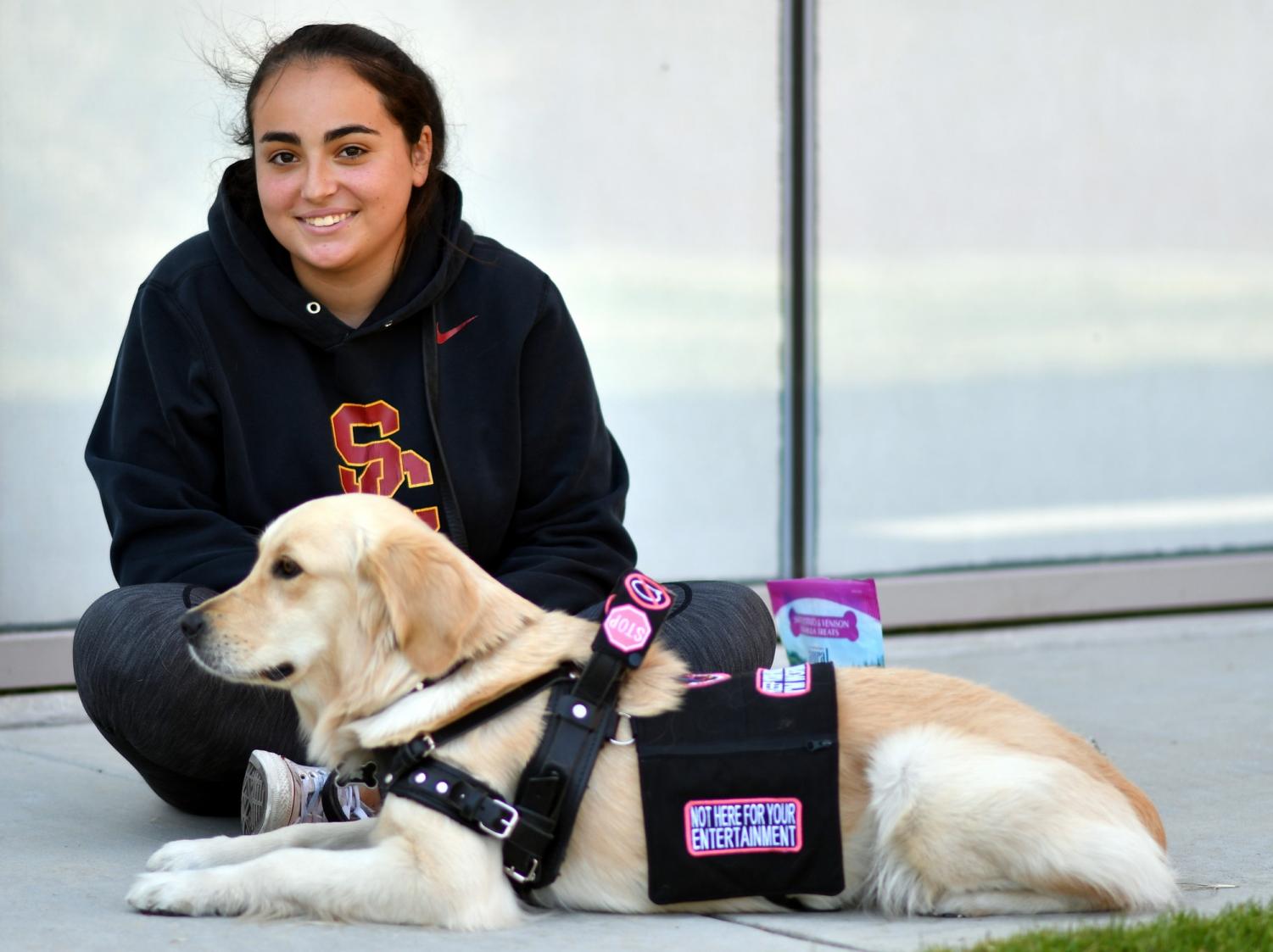Student shares the positives and negatives of having a service dog
El Camino student Dani Lindeman tells Warrior Life all about the perks, the benefits and the downfalls of having a service dog. She also shares how having a service dog has made her free.
May 29, 2018

Lying comfortably on the grass outside of the Humanities Building, Luca waits patiently for a treat from her handler, Dani Lindeman.
Dani has just finished exercising the nearly 2-year-old golden retriever who pants heavily in anticipation for Dani’s next command.
Dani Lindeman is a 19-year-old psychology student at El Camino who has an undiagnosed heart condition as well as post-traumatic stress disorder. Her service dog and companion Luca has many duties, but the biggest one is called “alerting”.
Alerting is a service dog’s physical response, such as pawing, nudging with its nose, or other signals to the outwardly visible cues their handler is unaware of.
According to the Americans with Disabilities Act (ADA), service animals are defined as dogs that are individually trained to do work or perform tasks for people with disabilities.
“I have a heart problem, and (Luca) will alert when my heart rate gets really high really quick. And I can either take medicine to calm down or do whatever I need to do obviously before it gets worse,” Dani says. “(Luca) prevents me from passing out.”
Dani says that she first noticed this condition about four years ago. Her father died when she was a freshman at South High School in Torrance. Soon after, she dropped out and began independent studies.
“I had dropped out of school because I was struggling a lot because I would get really, really dizzy, and I didn’t know what was going on,” Dani says.
Dani talked with her mother, Lisa, about what she was experiencing, and they went to see a doctor. That’s when they figured out that her heart rate was accelerating too high too quickly, and Dani says she’s still undergoing testing for a clear diagnosis.
Dani describes the next few years of her life as “isolation.” After her father died, she felt like everything came crashing down on her all at once. Though she says that her friends did their best to reach out to her, she thought that shutting everyone out was the best way to deal with her life at the time.
“I didn’t talk to some of my closest friends for two to three years. I spent most of my days in my room…and ignored everyone’s existence,” Dani says.
She didn’t think that anyone else could understand what she was going through.
It took a while, but Dani says, “I realized that I didn’t want to spend the rest of my life at home and being scared of the world wasn’t how I wanted to live.”

So she talked to her doctor and he told her about service dogs and what one could provide in her case. When Dani learned that having a service dog could help her go back to school, she was elated and immediately began looking into programs.
After she found out that getting a dog through a program could take anywhere from two to six years, she decided to “owner train,” which is owning a dog and training it yourself to be your service dog.
Enter the young, spunky, intelligent and adorable Luca. Dani got Luca when she was just 12 weeks old. The two have been inseparable ever since.
Luca is a cardiac alert dog. Since Dani suffers from a spontaneous accelerated heart rate that can lead to her passing out as well as anxiety which has the potential to produce panic attacks, Luca’s job is to alert her right away.
“Essentially, (Luca) forces me to recognize that something is affecting me, given I freeze up and need to remove myself before I end up having a panic attack,” Dani says.
Luca alerts by pawing at Dani’s leg. Dani will then sit down and do some breathing exercises to calm herself, ensuring that the situation doesn’t escalate.
According to the Center for Canine Behavior Studies website, it states, “Canines can detect rising cortisol levels in our sweat or breath.”
Humans have 12 million smell receptors in their nose. At the lowest estimate, dogs have 800 million smell receptors.
When Dani’s heart rate is elevated, she says that Luca can essentially smell the hormone called cortisol, otherwise known as the “stress hormone,” which our bodies secrete naturally when our heart rate increases rapidly. Luca will alert when she senses this.
“She’s sniffing a lot. She’ll lick at my mouth, which is really gross but that’s where the smell is coming from,” Dani says.
Luca has the alerting down and Dani says she’s still working on “retrieving” with her.
“Bringing medicine, picking up her leash for me. I’m also teaching her nightmare interruptions so if I’m having a nightmare she’ll wake me up,” Dani says. “She does other things like psychiatric tasks like interrupting (nervous]) scratching, crying, stuff like that.”
With Luca’s help, Dani was able to return to high school in the second semester of her senior year. It was an adjustment for her and hard at first, considering that having a service dog on campus was not typical for a student there.
“I went from being ‘Dani’ to ‘the girl with the dog.’ So, people would talk to me and I was like, you never talked to me before,” Dani says.

Dani’s high school teachers loved Luca. One of her teachers joked that she wanted to get Luca a dog bed. Another teacher would bring Luca dog treats.
“I had a really good experience with the teachers there,” Dani says.
As for her experience at El Camino, Dani says that “the students have been a lot more difficult to deal with.” She explains that in high school it was all the same kids. At least everybody recognized her and Luca because they would see them every day.
“Then we come (to El Camino) and it’s like, if I show up 20 minutes later it’s a different crowd of kids that are coming out (of classes). So, it’s another 10,000 people that I have to talk to and deal with every day,” Dani says.
Students and others tend to approach Dani and pet Luca multiple times throughout their day. In some cases, Dani is OK with it, but she would prefer people ask her first.
Dani wants people to know that if you approach a handler and pet a service dog without asking, it distracts the dog from working, which can potentially be dangerous. If Dani isn’t feeling well, she needs Luca’s full attention in the event that her heart rate does rise.
“I think a lot of people think they (service dogs) are just here for fun. Like, if I didn’t have to bring her everywhere, I definitely wouldn’t. She’s here for a reason, not just to look pretty and follow me around,” Dani says.
On Luca’s black vest, in white embroidery with a pink stitched border, it reads “KEEP YOUR HANDS OFF; I’M WORKING” and “NOT HERE FOR YOUR ENTERTAINMENT.”
Dani decided to stitch this onto Luca’s vest prevent verbal arguments with people who tend to overwhelm her or Luca.
For example, once at Disneyland, a child crawled under one of the rows while in line for the Disneyland Railroad and began petting Luca.
Dani said to the child’s father, “Excuse me, sir, can you get your kid because (Luca’s]) working right now?” To which the father replied, “Well you shouldn’t have brought your dog to Disneyland if you don’t want kids petting it.”
Dealing with these types of people is really hard for Dani, but she explains that it is these situations that have forced her to learn her rights and defend herself and she is now considering a future at USC Gould School of Law.
According to the ADA, there are only two questions employers/staff may ask: 1) is the dog a service animal required because of a disability, and 2) what work or task has the dog been trained to perform.
Staff cannot ask about the person’s disability, require medical documentation, require a special identification card or training documentation for the dog, or ask that the dog demonstrate its ability to perform the work or task, according to the ADA.
Luca goes everywhere with Dani. From her babysitting job to the beach. From Disneyland to her classrooms. Luca is always by her side.

In her free time, Dani enjoys photography and focuses mostly on taking photos of Luca. She’s even created a personal Instagram account for her service dog, @theteenygolden, which features portraits of the adorable golden retriever. Dani says that Luca loves to pose for pictures and believes that she’s quite photogenic.
It was through Luca’s Instagram account that Dani met her best friend Leslie Silva who had a service dog herself named Odin. Leslie reached out to Dani and they quickly bonded over their services dogs and mutual love for Disneyland.
“Sharing a friendship with Dani has been one of the best experiences in my life. The more time we spent together, the more I got to know (Dani) and love her,” Leslie shares.
“Often times when you have a disability and need a service dog, people become very distant and prefer not to hang around you. So the fact that Dani and I were so similar made things perfect for us,” Leslie says.
The quartet share a unique friendship. Dani and Leslie are able to enjoy themselves and have fun together, while “the pups keep us safe,” Leslie says.
“It’s really cool having someone that understands you. ” Dani says.
Dani makes a point to share that her friends that don’t have service dogs are understanding and accepting of Luca. Yet they can’t understand like another handler does.
Dani says that the biggest thing that Luca has brought to her life is freedom. Dani still struggles with the passing of her father. That is why Luca does a lot of psychiatric tasks for her.
“So, being able to go places again, I mean I hid away in my room for like three years. So, just having independence again is the biggest thing. Independence to go to school, wanting to pursue law. Like, things that never would have been possible before. So, (Luca’s) really given me my life back,” Dani says.


